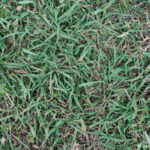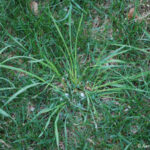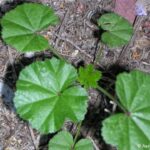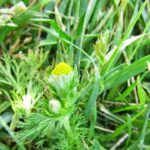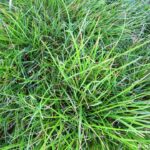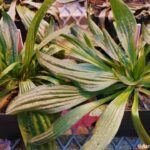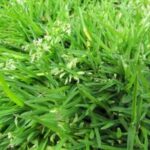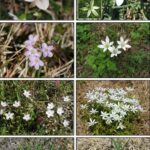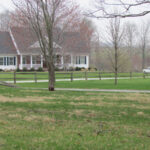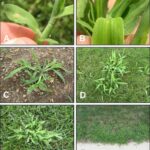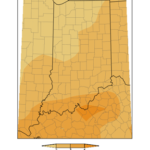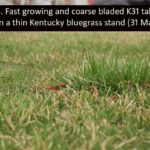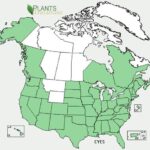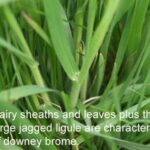Category: Weed Identification
Common Purslane
Purslane Biology: Common purslane (Portulaca oleracea L.) is a summer annual broadleaf weed (Fig. 1) that is commonly found in low maintenance turf swards (Fig. 2), turf seeded in summer (Fig. 3), next to sidewalks and driveways, and in mulched beds and gardens (Fig. 4). Purslane is a succulent plant with a prostrate growth habit, […]
Quackgrass
Quackgrass Biology: Quackgrass ( Elymus repens) is a cool-season perennial that vigorously spreads by rhizomes. It is a sod-forming grass that can crowd out desirable grasses and even other weeds. Quackgrass has been shown to be allelopathic, which means it releases chemicals that inhibit the growth of other plants. Large, nearly pure patches of […]
Orchardgrass
Biology: Orchardgrass (Dactylis glomerata), is a clump-forming, or bunch-type, cool-season grassy weed found throughout the Midwestern United States. It is typically used as a type of grazing or forage grass in pastures but it can be a weed in turf. It’s bunch-type growth pattern, light blue-greenish color, ability to tolerate partial shade, and rapid […]
Dandelion
Dandelion Biology: Dandelion (Taraxacum offinianale), is a broadleaf perennial weed that can be found in lawns, nursery crops, and landscapes throughout the United States. It has the ability to survive many different soil types, environmental conditions, and management practices; thus, it is a commonly found weed in lawns throughout the northern half of […]
Common Mallow
Common Mallow Biology: Common mallow (Malva neglecta), also known as cheese mallow, cheese weed, and dwarf mallow, is a winter annual broadleaf weed, though it can also act as a biennial if environmental conditions that favor growth persist. It is generally found in low-maintenance turfgrass lawns, nursery crops, and landscapes. The ability of […]
Pineapple Weed
Pineapple Weed Biology: Pineapple weed (Matricaria matricariodies), behaves as either a summer or winter annual and it is commonly found throughout the United States. It is a weed of both high- and low-maintenance turfgrass lawns, landscapes, and nursery crops. Its ability to tolerate low mowing heights and highly compacted soils allow pineapple weed to […]
Roughstalk Bluegrass
Roughstalk Bluegrass Biology: Roughstalk bluegrass, primarily known by its scientific name (Poa trivialis), is a cool-season perennial grass that can be found throughout the Midwestern United States. Though roughstalk bluegrass can be found in landscapes, roadsides, meadows, and waste areas, it is primarily considered a turfgrass weed. It can successfully germinate in multiple environmental […]
Buckhorn Plantain
Buckhorn Plantain Biology: Buckhorn plantain (Plantago lanceolata) is a perennial broadleaf that can be found in sites that are typically dry and consist of neutral to basic soils. Like the closely-related broadleaf plantain (Plantago major), buckhorn plantain can often be found in compacted soils but does not tolerate injury from constant traffic stress. It […]
Annual bluegrass starting to succumb to summer stress in lawns
Annual bluegrass (Poa annua) is a common weed on golf courses, but is now also becoming a problem on higher mowed turf areas such as lawns and athletic fields. This grass is lighter colored than Kentucky bluegrass and perennial ryegrass and can be identified by its boat-shaped leaf tip and membranous ligule (see Turf Tip […]
Spring Beauty and Star-of-Bethlehem
Both spring beauty (Claytonia virginica) and star-of-bethlehem (Ornithogalum umbellatum) are spring flowering weeds that are similar in appearance and sometimes problematic in lawns. Below is a comparison of the two species including control recommendations for both turf professionals and homeowners. Spring Beauty (Claytonia virginica) Star-of-Bethlehem (Ornithogalum umbellatum) Description: Small perennial plant originating from corms. Leaves […]
What’s that brown spot: Nimblewill in lawns
Nimblewill (Muhlenbergia schreberi) is a weed that thin patches in lawns. Since nimblewill is a warm-season grass, it will turn brown at the first frost and is very slow to green-up in the spring. The brown patches seen in lawns in the early spring may be nimblewill contamination. This weed spreads from seeds produced and […]
Top Ten Turf Tips of 2010
Part II: Summer diseases in Residential Turf Part III: Summer weeds: Common summer weeds and their control Part I: Too hot: Why some turfgrass species look poor in summer Color Variation in Residential and Commercial Lawns Crabgrass Control Now is the time to seed lawns and other turf areas Choosing a Preemergence Herbicide Late Fall […]
Crabgrass
Crabgrass is running rampant this year as the hot summer and more than adequate rainfall has helped to push this beast of a weed along. Crabgrass is a warm-season annual grass meaning that it thrives under hot and moist conditions. The high rainfall during germination (late April and early May) coupled with the wet and […]
Summer Stress
With a warm and wet summer, we are experiencing decline in some of our turf around the state due to temperatures, disease, insects, and weeds. In response, we are publishing a four part series on this topic to help turfgrass managers respond. Look forward to the following topics over the next two weeks. Part I: […]
Poa annua, Poa trivialis, and/or creeping bentgrass in lawns and sports fields
Poa annua (annual bluegrass), Poa trivialis (rough bluegrass) and creeping bentgrass are becoming common weeds in athletic fields and lawns. These weeds are important to distinguish because they require different controls. Poa annua: a winter annual that is lighter, more apple green than other lawn species. It is just past its aggressive seedhead stage, but you’ll likely still find […]
Knotweed germinating next to sidewalks and other hotspots
Prostrate knotweed is currently germinating in thin areas next to sidewalks, cart paths, driveways and other hotspots. Knotweed is often confused with crabgrass at this early stage. Knotweed leaves have rounded leaf tips whereas crabgrass has leaf tips that come to a dull point (See photos). Crabgrass also has veins running lengthwise (parallel veination) whereas […]
Lots of Colors in Spring Lawns
During spring green-up, lawns may reveal many variations in color, growth rate, and leaf width. This variation can be due to some of the following reasons: Species and cultivars: Perennial ryegrass is always the first of the desired cool-season grasses to green-up, followed by tall fescue and eventually Kentucky bluegrass (Fig. 1). Even within a species, […]
Yellow Nutsedge, The Scourge of Lawns and Landscapes in Nebraska
Yellow nutsedge (Cyperus esculentus) is a common, persistent and troublesome weed in lawns and landscapes in Nebraska. This is especially true from Kearney east into Iowa. Yellow nutsedge thrives in waterlogged soil and their presence often indicates that drainage is poor, irrigation frequency/quantity are excessive, or sprinklers/valves are damaged and leaking. Once this tenacious weed […]
Downy brome growing fast and furious in turf stands
The winter annual downy brome is growing aggressively in turf stands currently, almost twice as fast as the desired Kentucky bluegrass or tall fescue (photo). Downey brome is fairly easily identified at this time of the year by its hairy leaves and sheaths and it has a split collar with jagged membranous ligule (photo). It […]
Do-It-Yourselfer: Is it Crabgrass or Tall Fescue?
We have received a number of calls this year about trying to control the crabgrass running rampant in lawns. It’s a much more coarse bladed and lighter green than the rest of the grass, so it must be crabgrass? It’s not crabgrass and is more likely tall fescue. Though crabgrass and tall fescue may look […]

